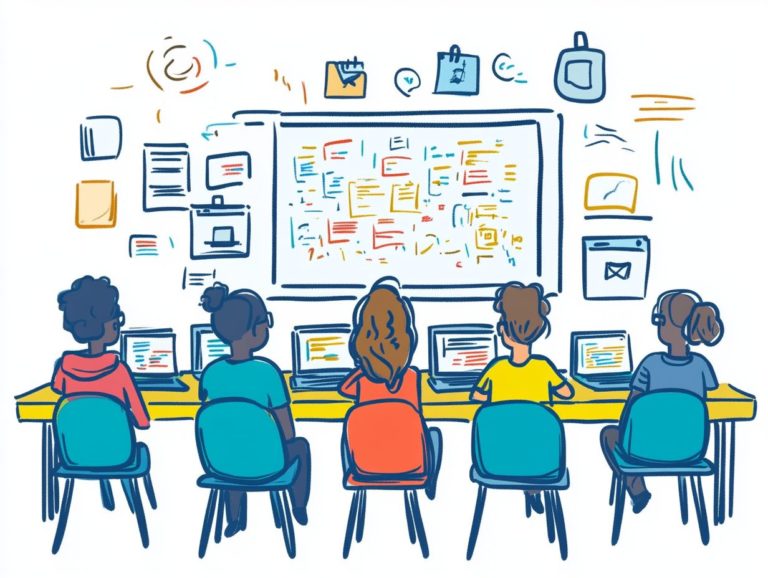How to Write Clean Code: Best Practices
Want your software projects to succeed? It all starts with clean code!
The quality of your code can make or break a project. Embracing clean code is crucial for promoting collaboration among developers and ensuring the long-term maintainability of your work. This article delves into the advantages of clean code, emphasizing foundational principles such as readability and efficiency.
You’ll discover best practices ranging from naming conventions to effective documentation, along with tools designed to help you uphold these high standards. Prepare to elevate your coding skills to new heights!
Contents
- Key Takeaways:
- The Importance of Writing Clean Code
- Key Principles of Writing Clean Code
- Best Practices for Writing Clean Code
- Tools for Ensuring Clean Code
- Frequently Asked Questions
- What is clean code and why is it important?
- What are some best practices for writing clean code?
- Why is it important to comment and document code?
- Should I prioritize writing efficient code over writing clean code?
- How can I ensure my code follows best practices for cleanliness?
- Are there any resources available to learn more about writing clean code?
Key Takeaways:

Clean code is crucial for developers and teams as it leads to increased efficiency, maintainability, and scalability. Key principles for writing clean code include a focus on readability, maintainability, and efficiency. Best practices for writing clean code include following naming conventions, proper commenting and documentation, and regularly testing and refactoring.
The Importance of Writing Clean Code
Writing clean code is about more than just efficiency. It makes products easier to maintain and improve over time. As software engineering continues to evolve, the demand for high-quality software that embraces clean code principles has never been more urgent.
Clean code promotes readability, making the codebase accessible to developers and minimizing the chances of bugs creeping in. It also fosters collaboration among teams. Maintainable code simplifies code reviews and debugging processes, elevating software quality.
Benefits of Clean Code for Developers and Teams
The benefits of writing clean code are invaluable for you as a software developer and for your entire team. Prioritizing clean code fosters a culture of quality and efficiency.
When you prioritize clean code, you significantly diminish the number of bugs that could emerge during the coding process. Imagine a team collaborating on a large project having maintainable code at their fingertips means navigating the debugging process with ease.
Cleaner code also enhances collaboration. Your teammates can grasp each other s work without sifting through convoluted logic. This clarity elevates the overall quality of the code and gives the power to your team to adapt swiftly to changes.
This results in quicker iteration cycles and reduced error-handling time. In essence, clean code serves as a common language, paving the way for a more harmonious and efficient workflow.
Key Principles of Writing Clean Code
Understanding the key principles of writing clean code is essential for establishing a solid foundation in effective software development practices. Prioritizing code that is both readable and maintainable is essential for all your projects.
Principles like the Single Responsibility Principle and the DRY (Don’t Repeat Yourself) principle meaning to avoid code duplication serve as invaluable guides for you as a software developer. They help ensure that your code meets functional requirements and enhance its long-term maintainability.
By embracing these principles, you ll find that errors become less frequent and error handling improves, culminating in more reliable software overall.
Readable and Maintainable Code
Readable and maintainable code is crucial for enabling your software to evolve smoothly. This allows you to navigate and understand the codebase with ease, especially in collaborative settings where multiple developers contribute over time.
By adhering to a consistent code formatting style, you enhance visual clarity and give your team members the ability to quickly grasp the structure and flow of the code. Opting for meaningful names for variables and functions can significantly boost comprehension. Instead of a vague identifier like ‘x’, using a name such as ‘totalCost’ gives immediate context.
Following established coding standards whether from the community or your organization ensures uniformity, enhancing both readability and maintainability. This leads to a smoother development process, making life easier for everyone involved.
Embrace these principles today and watch your coding skills soar!
Efficient and Scalable Code

Efficient and scalable code is vital for the long-term success of your software projects. It helps your systems handle growing demands without slowing down.
Finding the right balance between efficiency and scalability often depends on your choice of algorithms and programming languages. For example, using a language that optimizes resource use can greatly improve loading times and responsiveness.
Consider a popular e-commerce site that successfully managed heavy traffic during holiday sales. By using a design that allows different app parts to run independently, they achieved smooth operations even under load.
This example shows how smart coding choices enhance performance and set the stage for future upgrades.
Best Practices for Writing Clean Code
Implementing best practices for clean code makes your software development systematic. This approach reduces errors and improves teamwork among developers.
Naming Conventions and Formatting
Following naming conventions and formatting rules makes your code easier to read. This simplification helps you and your team understand and modify it quickly.
Using clear names for variables and functions communicates their purpose immediately. For instance, “calculateTotalPrice” is much clearer than “doStuff.”
Consistent formatting, like using camelCase for variable names, keeps your code organized. This standardization helps avoid horizontal scrolling and provides a cohesive view.
These practices simplify debugging and lead to faster project completion.
Commenting and Documentation
Great commenting and documentation can transform your code into a masterpiece! They make your work much clearer and easier for everyone involved.
Writing clear, concise comments and keeping documentation updated helps everyone understand your code better. This clarity fosters collaboration within your team.
New developers benefit greatly from thorough documentation, as it provides context and insights into the project’s structure. Properly documented code can speed up their learning curve, enabling them to contribute effectively.
A well-documented codebase supports quicker troubleshooting and enhances the success of your software projects.
Testing and Refactoring
Regular testing and refactoring are essential for maintaining clean code. They help identify and fix issues before they grow larger.
Unit tests ensure each component works correctly and give you immediate feedback. Test Driven Development (TDD) encourages you to write tests before coding, helping clarify requirements and expected behaviors.
Refactoring is crucial for clean code. By reviewing and improving existing code, you boost readability and reduce errors.
For instance, renaming variables or breaking down large functions can significantly enhance comprehension and teamwork.
Tools for Ensuring Clean Code

Utilizing the right tools to ensure clean code is crucial for your success in modern software development. These tools not only automate and streamline the coding process but also significantly enhance your productivity and code quality.
Code Linters and Analyzers
Code linters and analyzers are your essential allies in the quest for clean code. They help you find and fix mistakes in your code while identifying potential issues, ensuring your work complies with coding standards.
With their real-time feedback, these tools empower you to catch errors before your code even has a chance to run. This drastically reduces debugging time later in the development cycle.
They meticulously analyze your source code for syntax errors, formatting inconsistencies, and potential bugs, guiding you to adhere to best practices. You can easily integrate linters into your development workflow by including them in your build process or setting them to run during continuous integration checks.
This approach fosters a culture of clean coding practices, allowing you and your team to learn and adapt to writing better, more maintainable code. Ultimately, this leads to higher-quality software and smoother collaboration among team members.
Code Reviews and Pair Programming
Engaging in code reviews and pair programming presents a unique opportunity to enhance code quality while cultivating a culture of knowledge sharing within your software development team. By encouraging collaboration, you create an environment ripe for critical feedback and real-time problem-solving.
When you review each other’s work, you can catch potential issues early, leading to fewer bugs and more efficient code. Pair programming facilitates a seamless exchange of ideas, igniting creativity and boosting morale.
This interaction boosts team alignment and makes tackling complex tasks easier, resulting in a more cohesive and productive development environment.
Frequently Asked Questions
What is clean code and why is it important?
Clean code refers to well-written, easy-to-understand, and maintainable code. It is important because it can save time and effort in the long run, making it easier for other developers to work with your code.
What are some best practices for writing clean code?

Some best practices for writing clean code include using meaningful and consistent naming conventions, writing modular and reusable code, and regularly refactoring and optimizing code.
Why is it important to comment and document code?
Commenting and documenting code is important because it helps other developers understand the purpose and functionality of the code. It also makes it easier to maintain and update the code in the future.
Should I prioritize writing efficient code over writing clean code?
No, it is important to find a balance between efficiency and cleanliness in code. While efficient code can improve performance, it can also be difficult to understand and maintain.
Prioritizing clean code can lead to more efficient and effective code in the long run.
How can I ensure my code follows best practices for cleanliness?
One way to ensure your code follows best practices for cleanliness is to regularly review and refactor your code. You can also use tools and guidelines, such as coding standards, to help maintain cleaner code.
Are there any resources available to learn more about writing clean code?
Yes, there are many resources available, including books, online tutorials, and coding communities. Some popular resources for learning about clean code include “Clean Code” by Robert C. Martin and “Code Complete” by Steve McConnell.






